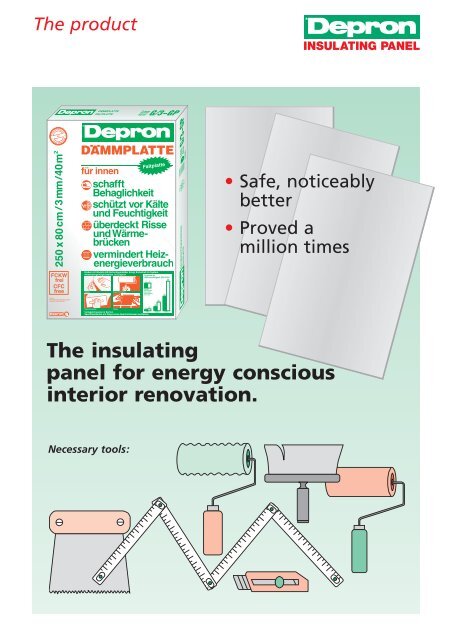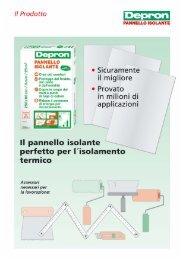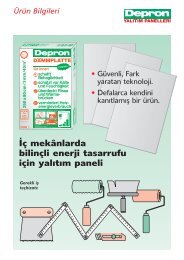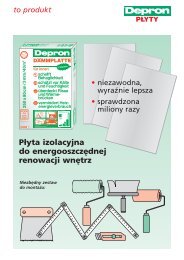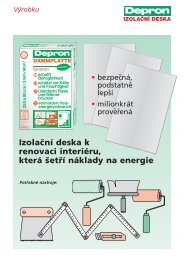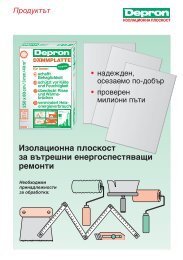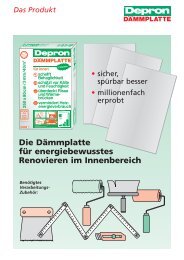The insulating panel for energy conscious interior renovation. - Depron
The insulating panel for energy conscious interior renovation. - Depron
The insulating panel for energy conscious interior renovation. - Depron
Create successful ePaper yourself
Turn your PDF publications into a flip-book with our unique Google optimized e-Paper software.
<strong>The</strong> product<br />
<strong>The</strong> <strong>insulating</strong><br />
<strong>panel</strong> <strong>for</strong> <strong>energy</strong> <strong>conscious</strong><br />
<strong>interior</strong> <strong>renovation</strong>.<br />
Necessary tools:<br />
• Safe, noticeably<br />
better<br />
• Proved a<br />
million times
Tips <strong>for</strong><br />
saving heating costs<br />
<strong>The</strong> heating cost shock due to the increased<br />
<strong>energy</strong> price will only hit most occupants when<br />
the next heating bill comes in!<br />
If there are separating walls between two<br />
differently heated rooms (e.g. 22°C/16°C) heat<br />
loss will occur. With regard to <strong>energy</strong> usage<br />
this fact is becoming more and more significant<br />
with high and further increasing <strong>energy</strong> prices.<br />
In order to reduce heat losses, it is advantageous<br />
to efficiently insulate the separating<br />
wall e.g. with a functional 6 mm thick <strong>Depron</strong><br />
<strong>insulating</strong> <strong>panel</strong> (see diagram) on both sides.<br />
<strong>The</strong> fine, closed cell structure provides excellent<br />
insulation even with a relatively thin <strong>insulating</strong><br />
thickness (e.g. in relation to<br />
construction polystyrene, glass wool or rock<br />
wool). Around 34 litres of fuel oil per year<br />
„flow“ through an uninsulated 10 m2 wall<br />
(4 x 2.5 m) with a k-value = 1.96 (11.5 cm<br />
cellular concrete, plastered on both sides).<br />
22°C<br />
Around 20 litres of fuel oil per year „flow“<br />
through the same wall when it is covered with<br />
a 6 mm <strong>Depron</strong> <strong>insulating</strong> <strong>panel</strong> on both sides<br />
with a k – value of 1.18.<br />
That’s a saving of 40%.<br />
If an unheated room has a temperature of<br />
just 7°C (e.g. staircase) with the double side<br />
heat insulation there is a reduced heat loss or<br />
an annual saving of 35 litres of fuel oil.<br />
In this way the total heating costs can be<br />
reduced by 11% to 14.4%.<br />
<strong>The</strong> surface temperature of the inner wall can<br />
be increased by up to 5% in winter.<br />
<strong>The</strong> time it takes <strong>for</strong> the room to heat up will<br />
be accelerated.<br />
16°C<br />
Stick on <strong>Depron</strong> – save heating costs
Living without<br />
damp damages<br />
Problem areas<br />
Damp and mould damages due<br />
to <strong>for</strong>mation of condensation,<br />
marks, heat loss<br />
On cold component surfaces:<br />
• Wall surfaces behind furniture and curtains<br />
• Outside walls with high heat absorption<br />
(heavy materials)<br />
• Ceiling areas under unheated rooms<br />
• Separating walls to unheated adjoining<br />
rooms/staircases<br />
Measures<br />
• Check penetration of wet and damp from<br />
outside<br />
• Eliminate possible constructional defects<br />
• Dry components<br />
• Take off wallpaper with a wall paper<br />
remover<br />
• Clean plastered areas (abrade, suck out)<br />
• Impregnate plastered areas with fungicidal<br />
solution<br />
• Dry plastered areas and room very well<br />
(turn on heater or condensation dryer)<br />
Renovation / refurbishment<br />
• Improve damaged areas of wall and ceiling<br />
with a filler and smooth out uneven and<br />
rough areas with a smoother.<br />
• Stick <strong>Depron</strong> <strong>insulating</strong> <strong>panel</strong>s onto ceiling<br />
areas, outside walls, window jambs, roller<br />
shutter areas<br />
• Use high quality filled dispersion adhesive<br />
to stick it on<br />
• Always stick <strong>Depron</strong> <strong>insulating</strong> <strong>panel</strong>s onto<br />
edges which close tightly, preferably in a<br />
On thermal bridges:<br />
• Ceiling coating (ring beam)<br />
• Window lintels<br />
• Reveals<br />
• Room corners<br />
• Mortar joints<br />
• Joints of construction and insulation <strong>panel</strong>s<br />
• Fasteners (steel anchors, nails, screws)<br />
• Move cupboards away from wall areas,<br />
hang curtains at a large interval from the<br />
wall (rear ventilation is required!)<br />
• Outside wall corners must remain clear<br />
(do not place any furniture there)<br />
• Control air humidity and temperature in the<br />
room with a hygrometer/thermometer<br />
• By ventilating and heating consistently keep<br />
the room air humidity under 60% relative<br />
humidity (in winter time)<br />
double cut procedure (see processing instructions)<br />
• Carry out spatula work on <strong>Depron</strong> <strong>insulating</strong><br />
<strong>panel</strong> with dispersion spackle.<br />
• Be<strong>for</strong>e wallpapering with high quality<br />
wallpapers and wall coverings, stick on the<br />
roll maculature.<br />
This serves as a tension bearer and a damp<br />
buffer together with the wallpaper
Processing instructions /<br />
work steps<br />
You can get <strong>Depron</strong> <strong>insulating</strong> <strong>panel</strong>s in 3 mm<br />
and 6 mm thickness, each with ready to use<br />
wall paper primer or without primer.<br />
Suitable undercoat<br />
Wall and ceiling surfaces which are professionally<br />
laid out in a normal construction.<br />
<strong>The</strong> under coat must be dry, stable, clean, even,<br />
smooth and absorbent.<br />
Under coat pre-treatment<br />
Loosen old wallpaper, water soluble and non<br />
fixed adhesive paint with paint stripper and<br />
remove completely. Use a filling spackle to fill<br />
in fissures, holes, joints and breaks. Remove<br />
dust from smoothed putty areas and ground<br />
with penetrating primer.<br />
Rough plaster/structural plaster: Chip off<br />
prominent graining, clean areas and smooth<br />
Work steps<br />
<strong>Depron</strong> <strong>insulating</strong> <strong>panel</strong> with ready to use<br />
wallpaper primer coat:<br />
Applying adhesive<br />
Apply the adhesive to the<br />
under coat evenly in an<br />
area the size of the <strong>panel</strong><br />
using a notched trowel<br />
(notch shape B1).<br />
Laying the <strong>panel</strong><br />
Place the <strong>Depron</strong> <strong>insulating</strong><br />
<strong>panel</strong> with the marked<br />
backside („DEPRON“<br />
imprint) in the wet adhesive<br />
and roll it out well. Roll<br />
out air bubbles to the sides.<br />
Gluing the caulked joint<br />
Always glue the following<br />
<strong>insulating</strong> <strong>panel</strong>s tightly to<br />
the joint or so that they are<br />
overlapping (remove the<br />
double cut - remaining<br />
strips).<br />
with smoothing spatula. Prime and/or fix highly<br />
absorbent under coats, lightly sandy and<br />
chalky plaster with penetrative primer. Solution<br />
containing primers (e.g. on wooden construction<br />
<strong>panel</strong>s) must be completely ventilated.<br />
Thoroughly clean and dry damp undercoats,<br />
mouldy areas or blooms and eliminate the<br />
cause of the moisture penetration.<br />
Adhesives <strong>for</strong> <strong>Depron</strong> <strong>insulating</strong> plates<br />
On absorbent under coats we recommend<br />
using a filled dispersion adhesive. On non<br />
absorbent under coats e.g. plastics, metal,<br />
glass, ceramics, contact adhesives can be used.<br />
• Omission of a work process<br />
• Cost saving<br />
• Increased processing safety<br />
• Facilitation of processing<br />
• EPÜ Patent No. 0 109 663 on primer coat<br />
Roll it out well<br />
Roll out the cutting edges<br />
evenly with the rubber<br />
roller. Any later filling<br />
which is required is to be<br />
carried out using dispersion<br />
spackle. Remove dust from<br />
smoothed putty areas and<br />
prime in the case of high<br />
absorbency.<br />
<strong>Depron</strong> <strong>insulating</strong> <strong>panel</strong><br />
without primer coat:<br />
A primer coat should be<br />
applied onto the untreated<br />
<strong>Depron</strong> surface directly<br />
after gluing.<br />
Drying times<br />
Adhesive and subsequently<br />
applied primer coats must<br />
be left to dry <strong>for</strong> at least 24<br />
hours. <strong>The</strong> drying of the<br />
adhesive and firm position<br />
of the <strong>Depron</strong> <strong>insulating</strong><br />
<strong>panel</strong>s are to be checked in<br />
several positions using a<br />
cross section and removal<br />
test, be<strong>for</strong>e it is further<br />
processed.
Areas of use<br />
Wallpapers and wall coverings<br />
can be affixed with paste or<br />
glue products according to the<br />
type. In the case of very high<br />
quality and very high tension<br />
wallpapers, roll maculature is<br />
to be glued on be<strong>for</strong>ehand.<br />
Glass fibre textiles and<br />
structural fibre fleece<br />
are glued. After drying they<br />
can be painted over with<br />
acrylic, latex or dispersion<br />
paints.<br />
Renovation fleece and<br />
painters fleece<br />
can be affixed using unfilled<br />
dispersion adhesive or can be<br />
embedded in special dispersion<br />
spackle and filled dispersion<br />
adhesive which overlaps the<br />
joints.<br />
1<br />
2<br />
3<br />
4<br />
5<br />
6<br />
7<br />
8<br />
9<br />
10<br />
11<br />
12<br />
13<br />
14<br />
Artificial resin, dispersion and<br />
roller plater of all kinds ...<br />
are applied to the <strong>Depron</strong><br />
<strong>insulating</strong> <strong>panel</strong>s without<br />
rein<strong>for</strong>cement textiles. As an<br />
additional primer we<br />
recommend painting plaster<br />
with 10% water addition,<br />
matched to the colour of the<br />
subsequent plaster application.<br />
Stoneware wall tiles<br />
Can be directly applied to the<br />
<strong>Depron</strong> <strong>insulating</strong> <strong>panel</strong> with<br />
dispersion tile adhesive. <strong>The</strong>y<br />
can be attached after four days<br />
drying time.<br />
Renovation work on <strong>Depron</strong><br />
Old wallpaper can be removed<br />
without damaging the <strong>Depron</strong><br />
<strong>insulating</strong> <strong>panel</strong>s. If it is not<br />
possible to remove it dry, the<br />
wallpaper should be loosened<br />
with a wallpaper remover.<br />
on cold outside walls<br />
(as an addition to a WDVS)<br />
on damp – cold outside walls<br />
on cold separating walls<br />
on cold cellar walls<br />
on thermal bridges (marks),<br />
cracks in plaster<br />
in room corners (mould)<br />
<strong>for</strong> heat loss in heater niches<br />
in window and door jambs<br />
on and in roller shutter casings<br />
on walls behind furniture<br />
on ceiling surfaces<br />
on roof slopes<br />
as an under coat <strong>for</strong> floor heating<br />
under chip board, prefabricated parquet<br />
and laminate floors (tongue and groove<br />
systems) and <strong>for</strong> many handicrafts in model<br />
building
Technical data<br />
CFC free<br />
Type of material: extruded polystyrene hard<br />
foam in <strong>panel</strong> <strong>for</strong>m<br />
Thickness: 3 mm and 6 mm<br />
Density: 40 kg/m3 / 33 kg/m3 according to DIN 53420<br />
Dimension: 1,25 m x 0,80 m<br />
Heat conductance: 0.030 W/mK (measurement<br />
according to DIN 52612)<br />
When graded in the heat conductance group<br />
035 (calculation value λR = 0.035 W/mK) there is<br />
a thermal resistance of 0.17m2 K/W <strong>for</strong> <strong>Depron</strong><br />
<strong>insulating</strong> <strong>panel</strong>s, thickness 6 mm.<br />
Special features:<br />
<strong>Depron</strong> <strong>insulating</strong> <strong>panel</strong><br />
• quickly increases the surface temperature<br />
during heat circulation<br />
• does not take in any water, is not imbued<br />
• reduces the penetration of water vapour,<br />
offers moisture protection <strong>for</strong> walls and<br />
ceilings<br />
<strong>Depron</strong> <strong>insulating</strong> <strong>panel</strong> 3 mm / 6 mm<br />
Water vapour<br />
diffusion resistance<br />
value: 650 / 450<br />
according to DIN 52615<br />
Water vapour<br />
retarder value µ · s: 2,0 m / 2,7 m<br />
<strong>Depron</strong> <strong>insulating</strong> <strong>panel</strong><br />
• with ready to use wallpaper primer it is:<br />
B2 (normally flammable) according to<br />
DIN 4102, in connection with many different<br />
wallpapers. Testing by MPA NRW, Dortmund.<br />
Test certificate no. 23 1044 392-2<br />
• with ready to use wallpaper primer it is<br />
flame retardant in connection with tiles,<br />
plastic plaster, dispersion paint, glass fibre<br />
material<br />
• is resistant to cement, lime scale, gypsum<br />
and salt (blooms), alkalis and against nearly<br />
all aqueous media (not resistant to organic<br />
solvents)<br />
<strong>Depron</strong> <strong>insulating</strong> <strong>panel</strong> 6 mm<br />
has the same heat insulation value as:<br />
<strong>Depron</strong> <strong>insulating</strong> <strong>panel</strong> 3 mm: half values<br />
• does not decay and go mouldy, does not<br />
offer nutrition <strong>for</strong> mildew, is odourless<br />
• can be used both as a moisture protective<br />
middle layer and to increase the heat and<br />
impact noise insulation under chipboard,<br />
ready to use parquet and laminate floors<br />
(tongue and groove systems)<br />
Impact noise improvement<br />
measure ∆lw: +16 dB according to DIN 52210<br />
Compressive stress at 10%<br />
compression: 0.1 MPa according to DIN 53421<br />
<strong>The</strong> processing guidelines of the parquet<br />
manufacturer must be adhered to.<br />
überreicht durch:<br />
24 mm<br />
pine wood<br />
100 mm<br />
brick wall<br />
360 mm<br />
normal concrete<br />
9/2009 – GB


